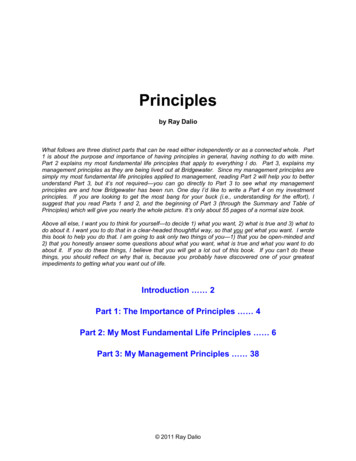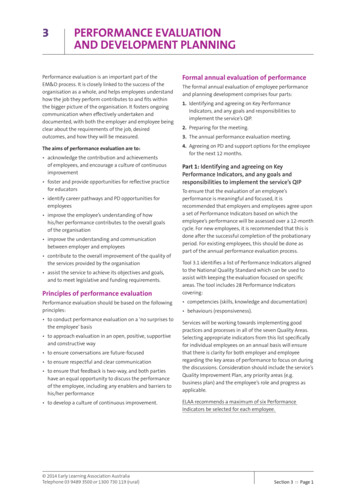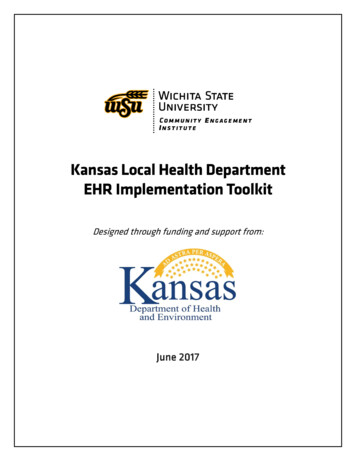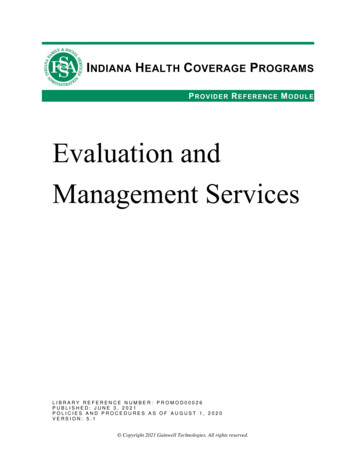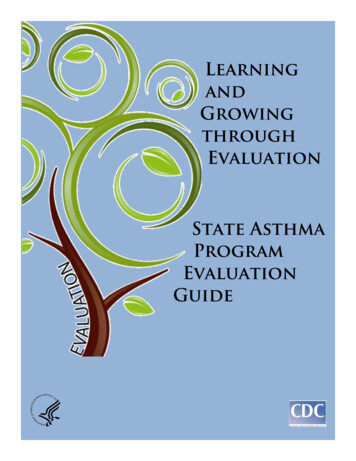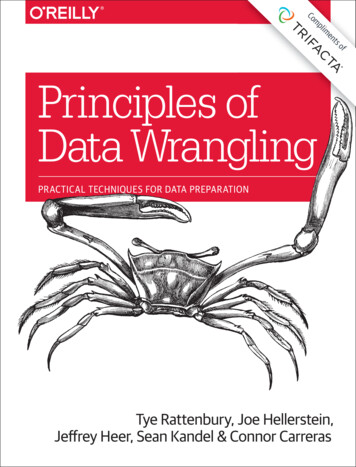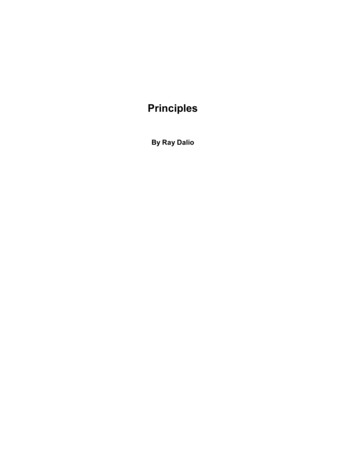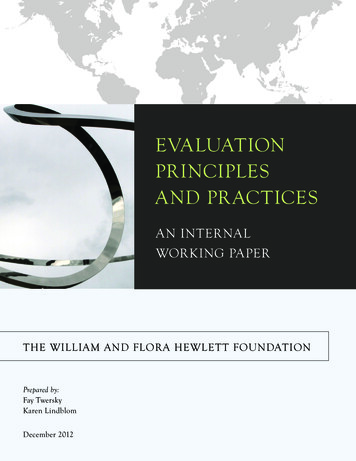
Transcription
EVALUATIONPRINCIPLESAND PR ACTICESAN INTERNALWORKING PAPERTHE WILLIAM AND FLORA HEWLETT FOUNDATIONPrepared by:Fay TwerskyKaren LindblomDecember 2012
TABLE OF CONTENTSINTRODUCTION.3History. 4Intended Audience. 4THE HEWLETT FOUNDATION’S SEVEN PRINCIPLESOF EVALUATION PRACTICE.5ORGANIZATIONAL ROLES.7Program and Operational Staff. 7Central Evaluation Support. 8Organizational Checks and Balances. 9PRACTICE GUIDE: PLANNING, IMPLEMENTATION, AND USE.10Planning. 10Beginning Evaluation Design Early. 10Clarifying an Evaluation’s Purpose. 11Choosing What to Evaluate. 12Defining Key Questions. 14Timing: By When Do We Need to Know?. 16Selecting Methods. 17Engaging with Grantees. 17Crafting an RFP for an Evaluator. 18Choosing an Evaluator and Developing an Agreement. 18Implementation. 19Managing the Evaluation. 19Responding to Challenges. 19Synthesizing Results at the Strategy Level. 20Using Results. 20Taking Time for Reflection . 20Sharing Results Internally. 20Sharing Results Externally. 21SPECIAL EVALUATION CASES.22Evaluating Regranting Intermediaries. 22Think Tank Initiative. 23APPENDIX A: GLOSSARY.25APPENDIX B: EVALUATION CONSENT IN GRANT AGREEMENT LETTERS.28APPENDIX C: PLANNING TOOL: SHARING RESULTS.29APPENDIX D: ACKNOWLEDGMENTS.30Cover image: Measuring Infinity by Jose de Rivera at the Smithsonian Museum of American History
INTRODUCTIONEVALUATION IS PART OF THE FABRIC OF THE WILLIAM AND FLORA HEWLETTFoundation. It is referenced in our guiding principles. It is an explicit element of ouroutcome-focused grantmaking. And evaluation is practiced with increasing frequency,intensity, and skill across all programs and several administrative departments in theFoundation.The purpose of this document is to advance the Foundation’s existing work sothat our evaluation practices become more consistent across the organization.We hope to create more common understanding of our philosophy, purpose,and expectations regarding evaluation as well as clarify staff roles and available support. With more consistency and shared understanding, we expectless wheel re-creation across program areas, greater learning from each other’sefforts, and faster progress in designing meaningful evaluations and applyingthe results.The following paper is organized into four substantive sections: (1) Principles,(2) Organizational Roles, (3) Practice Guide, and (4) Special EvaluationCases. Supporting documents include a glossary of terms (Appendix A). ThePrinciples and Organizational Roles should be fairly enduring, while thePractice Guide should be regularly updated with new examples, tools, andrefined guidance based on lessons we learn as we design, implement, and useevaluations in our work.1Hewlett FoundationGuiding Principle #3:The Foundation strives tomaximize the effectivenessof its support.This includes the application of outcome-focusedgrantmaking and thepractice of evaluating theeffectiveness of our strategies and grants.What Is Evaluation?Evaluation is an independent, systematic investigation into how, why, and to whatextent objectives or goals are achieved. It can help the Foundation answer key questions about grants, clusters of grants, components, initiatives, or strategy.What Is Monitoring?Grant or portfolio monitoring is a process of tracking milestones and progress againstexpectations, for purposes of compliance and adjustment. Evaluation will often drawon grant monitoring data but will typically include other methods and data sourcesto answer more strategic questions.1While we appreciate the interconnectedness of strategy, monitoring, organizational effectiveness, and evaluation, this paper does NOT focus on those first three areas. Those processes have been reasonably welldefined in the Foundation and are referenced, as appropriate, in the context of evaluation planning, implementation, and use.3
4EVALUATION PRINCIPLES AND PRACTICESHistoryRecently, the Foundation adopted a common strategic framework to be usedacross all its program areas: Outcome-focused Grantmaking (OFG).2 Monitoringand evaluation is the framework’s ninth element, but expectations about whatit would comprise have not yet been fully elaborated. Some program teamshave incorporated evaluation at the start of their planning, while others havelaunched their strategies without a clear, compelling evaluation plan.The good news is that, two to three years into strategy implementation, theseprograms typically have commissioned generally useful evaluations. The badnews is that they likely missed important learning opportunities by starting evaluation planning late in the process. Bringing evaluative thinking anddiscipline to the table early and often helps sharpen a strategy by clarifyingassumptions and testing the logic in a theory of change. Early evaluation planning also helps avoid the penalties of a late start: (1) missing a “baseline”; (2)not having data available or collected in a useful common format; (3) surprised,unhappy, or unnecessarily burdened grantees; and (4) an initiative not optimally designed to generate the hoped-for knowledge.Based on these lessons of recent history, we are adapting our evaluation practice to optimize learning within and across our teams. Staff members are eagerfor more guidance, support, and opportunities to learn from one another. Theyare curious, open-minded, and motivated to improve. Those are terrific attributes for an evaluation journey, and the Foundation is poised to productivelyfocus on evaluation at this time.This paper is the result of a collaborative effort, with active participation froma cross-Foundation Evaluation Working Group. Led by Fay Twersky and KarenLindblom, members have included Paul Brest, Susan Bell, Barbara Chow, RuthLevine, John McGuirk, Tom Steinbach, Jen Ratay, and Jacob Harold.Intended AudienceOriginally, this paper’s intended audience was the Hewlett Foundation’s staff—present and future. And of course, the process of preparing the paper, of involvingteams and staff across the Foundation in fruitful conversation and skill building,has been invaluable in perpetuating a culture of inquiry and practical evaluation. Since good evaluation planning is not done in a vacuum, we asked asample of grantees and colleagues from other foundations to offer input on anearlier draft. They all encouraged us to share this paper with the field, as theyfound it to be “digestible” and relevant to their own efforts.While our primary audience remains Foundation staff, we now share the paperbroadly, not as a blueprint, but in a spirit of collegiality and an interest in contributing to others’ efforts and continuing our collective dialogue about evaluation practice.2See the Hewlett Foundation’s OFG memo for a complete description of this approach.
THE HEWLETT FOUNDATION’S SEVENPRINCIPLES OF EVALUATION PRACTICEWe aspire to have the following principles guide our evaluation practice:1.We lead with purpose. We design evaluation with actionsand decisions in mind. We ask, “How and when will weuse the information that comes from this evaluation?” Byanticipating our information needs, we are more likely todesign and commission evaluations that will be useful andused. It is all too common in the sector for evaluations tobe commissioned without a clear purpose, and then to beshelved without generating useful insights. We do not wantto fall into that trap.2.Evaluation is fundamentally a learning process. As weengage in evaluation planning, implementation, and useof results, we actively learn and adapt. Evaluative thinkingand planning inform strategy development and target setting.They help clarify evidence and assumptions that undergirdour approach. As we implement our strategies, we use evaluation as a key vehicle for learning, bringing new insights toour work and the work of others.3.We treat evaluation as an explicit and key part of strategydevelopment. Building evaluative thinking into our strategydevelopment process does two things: (1) it helps articulatethe key assumptions and logical (or illogical) connections ina theory of change; and (2) it establishes a starting point forevaluation questions and a proposal for answering them in apractical, meaningful sequence, with actions and decisions inmind.4.We cannot evaluate everything, so we choose strategically. Several criteriaguide decisions about where to put our evaluation dollars, including theopportunity for learning; any urgency to make course corrections or futurefunding decisions; the potential for strategic or reputational risk; size ofinvestment as a proxy for importance; and the expectation of a positiveexpected return from the dollars invested in an evaluation.5.We choose methods of measurement that allow us to maximize rigorwithout compromising relevance. We seek to match methods to questionsand do not routinely choose one approach or privilege one method overothers. We seek to use multiple methods and data sources when possible inorder to strengthen our evaluation design and reduce bias. All evaluationsclearly articulate methods used and their limitations.5
6EVALUATION PRINCIPLES AND PRACTICES6.We share our intentions to evaluate, and our findings, with appropriateaudiences. As we plan evaluations, we consider and identify audiencesfor the findings. We communicate early with our grantees and co-fundersabout our intention to evaluate and involve them as appropriate in issuesof design and interpretation. We presumptively share the results of ourevaluations so that others may learn from our successes and failures. Wewill make principled exceptions on a case-by-case basis, with care given toissues of confidentiality and support for an organization’s improvement.7.We use the data! We take time to reflect on the results, generate implications for policy or practice, and adapt as appropriate. We recognize thevalue in combining the insights from evaluation results with the wisdomfrom our own experiences. We support our grantees to do the same.}We seek to maximize rigorwithout compromisingrelevance.}
ORGANIZATIONAL ROLESAs the Foundation develops more formal systems and guidance for our evaluation work, it is appropriate to clarify basic expectations and roles for staff. Asthis work matures, and as our new central evaluation function evolves, we willcontinue to identify the best approaches to evaluation and refine these expectations accordingly.Although we address the amount of time and effort staff may be expected togive to this work, it is important to note that the Foundation is less interestedin the number of evaluations than in their high quality. Our standards aredefined in the principles above and also informed by our practical learning andapplication of lessons.Program and Operational StaffProgram and relevant operational staff (e.g., in theCommunications and IT departments) are responsible andaccountable for designing, commissioning, and managingevaluations, as well as for using their results. Programs arefree to organize themselves however they deem most effective to meet standards of quality, relevance, and use. Theymay use a fully distributed model, with program officersresponsible for their own evaluations, or they may designatea team member to lead evaluation efforts.}Program and operationalstaff have primary responsibilityfor the evaluations theycommission.}At least one staff member from each program will participate in a cross-Foundation Evaluation Community of Practice in order to support mutual learningand build shared understanding and skills across the organization. This participant could be a rotating member or standing member.As part of programs’ annual Budget Memo process and mid-course reviews,staff will summarize and draw on both monitoring and evaluation data—providing evidence of what has and has not worked well in a strategy and why.Staff are expected to use this data analysis to adapt or correct their strategy’scourse.In general, program officers will spend 5 to 20 percent of their time designingand managing evaluations and determining how to use the results. This overallexpectation is amortized over the course of each year, though of course thereare periods when the time demands will be more or less intensive. The most intensive time demands tend to occur at the beginning and endof an evaluation—that is, when staff are planning and then using results.7
EVALUATION PRINCIPLES AND MPLEMENTATION—LOWERDuring these periods, full days can be devoted to the evaluation. Forinstance, planning requires considerable time to clarify design, refine questions, specify methods, choose consultants, and set up contracts. During use,staff spend time meeting with consultants, interpreting results, reviewingreport drafts, communicating good or bad news, and identifying implicationsfor practice. Less staff time is usually required during implementation, while evaluatorsare collecting data in the field. Ongoing management of their work takessome time, but, on the whole, not as much.In general, program officers are expected to effectively manage one significantevaluation at any given time (maybe two, under the right circumstances). Thisincludes proper oversight at each stage, from design through use and sharing ofthe results. When planning how to share results broadly, program staff shouldconsult with the Foundation’s Communications staff about the best approach.Central Evaluation SupportAs our approach to evaluation has become more deliberate and systematic,the Foundation’s leadership has come to appreciate the value and timelinessof expert support for this work across the organization. Therefore, as part of itsnew Effective Philanthropy Group, the Foundation is creating a central supportfunction for programs’ evaluation efforts. It will: Provide consultation during strategy development, includingteasing out assumptions and logical underpinnings in thetheory of change. Support program staff in framing evaluation priorities, questions, sequencing, and methods. Help develop Requests forProposals (RFPs) and review proposals.}Central evaluation support isoriented toward consultation,NOT compliance. Maintain updated, practical, central resources: a vetted listof consultants with desired core competencies; criteria for assessing evaluation proposals; and examples of evaluation planning tools, RFPs, and}
EVALUATION PRINCIPLES AND PRACTICESevaluation reports, including interim reports, internal and external reports,and executive summaries. Coordinate with the Foundation’s OrganizationalLearning staff. Develop, test, and support the implementation of an application templateand workflow for evaluation grants, including grant agreement letters.Coordinate with the relevant Foundation administrative departments:Grants Management and Legal. Provide or broker evaluation training for program staff in different formats(e.g., internal workshops, on-the-job training and coaching, and referrals toexternal resources, as appropriate). Spearhead an internal Evaluation Community of Practice for program staffwho are leading evaluation efforts in their teams and want to share anddeepen their skills and knowledge. Support external sharing of results as appropriate—coordinating withrelevant program, Legal and Communications staff as well as grantees andother external partners. Work with Human Resources to refine job descriptions and performancereview tools to accurately reflect evaluation responsibilities. Debrief every evaluation with the appropriate program staff: what wentwell, what didn’t, key lessons, and actions taken as a result. Synthesize andshare relevant lessons with other program staff so they can benefit frompromising practice and lessons learned. Position the Foundation as a leader in the philanthropic evaluation field, inclose coordination with Communications staff. Stay current with and contribute to the state of the art of evaluation. Coordinate as needed with the Human Resources, Organizational Learning,Philanthropy Grantmaking, and Organizational Effectiveness staff onany overlapping areas of learning, assessment, and training—both forFoundation staff and grantees.Organizational Checks and BalancesHow do we ensure that the Foundation does not simply commission evaluations that give us the answers we want? The practice guide that follows outlinesa number of steps we are taking including: (1) building evaluation in from thebeginning of a strategic initiative; (2) involving our board of directors in articulating key evaluation questions and then circling back with answers when wehave them; (3) requiring methodology be clearly articulated for every evaluation—methodology that maximizes both rigor and relevance; (4) providingcentral expertise to review evaluation designs, proposals, and help interpretfindings; (5) considering alternative explanations when interpreting results; and(6) debriefing every evaluation experience with a central evaluation officer—on all relevant lessons—to guard against easy answers or ignoring key findings.9
PRACTICE GUIDE: PLANNING,IMPLEMENTATION, AND USEThis Practice Guide follows the three stages of evaluation:(1) planning, (2) implementation, and (3) practical use ofthe evaluation findings. Throughout this guide, we speakabout evaluations as being conducted by independentthird parties. That is distinct from monitoring activitieswhich are typically conducted internally by Foundationprogram staff.PlanningPlanning is the most important and complex part of evaluation. Below are key steps and case examples that illustrate successes, pain points, and lessons learned.Beginning evaluation design earlyAs part of the OFG process, a program team shouldconsider the key assumptions in its theory of change anddecide which warrant being systematically tested.Often these are the assumptions that link the boxes in thecausal chain of a logic model. For instance, consider thisexample of a simplified generic theory: If we invest in an innovative model, we hope and planfor it to be successful, and if proven successful, it will be scaled to reach manymore people.In between each link are potential assumptions to betested: This innovative approach can be successful. Effective organizations exist that can implement thisapproach. This approach can become a “model,” and not just aone-off success.10Start evaluation planning early!Six years after starting the ten-year SpecialInitiative to Reduce the Need for Abortion,Foundation staff began planning an evaluationwhose primary purpose was to contribute toinforming the staff and Board’s future fundingdecision.Designing an evaluation at this stage of implementation created challenges, some of whichcould have been minimized had an evaluationframework been established from the outset.First, some of the long-term goals (e.g., reducingthe number of abortions in the United States by50 percent) do not now seem feasible and the“intermediate” targets are also high level and longterm. If evaluative thinking had begun earlier,target setting might have been more realistic, andintermediate aims could have been identified andprogress could have been measured in a systematic way.Second, consultations with Foundation leadershipduring evaluation planning revealed an interest inanswering questions about attribution (e.g., howmuch did this intervention cause the observeddramatic declines in the rate of teen pregnancy).However, the Initiative had not been designed toanswer those questions.Third, as a result, the evaluation was left to answertwo questions at once, risking revisionist thinking:(1) what would have been possible for success atthis point? and (2) how much progress has theInitiative actually made?Key reflection: it would have been valuable tobring evaluative thinking to bear earlier in the process, as well as to allocate time and money for anevaluation from the start. The original evaluationplan would likely have needed modification overtime, but still would have been a useful tool.
EVALUATION PRINCIPLES AND PRACTICES Others will be interested in adopting and supporting the model. Resources for growth and expansion exist to scale the model.As with many strategies, each link builds on the one before. So threshold evaluation questions that can help inform future direction are important to answerrelatively early in the strategy’s life. For instance, we might want to know firstif an approach is effectively implemented and then if it is achieving desired outcomes before we advocate for scale.This kind of evaluative thinking can help sharpen a theory of change from theoutset, inform the sequencing of grantmaking, and highlight interdependenciesto be supported or further explored.Starting evaluation planning early in a strategy development process, ratherthan midway through an initiative, protects against four common pitfalls: (1)missing a “baseline”; (2) not having data available or collected in a useful common format; (3) surprised, unhappy, or unnecessarily burdened grantees; and(4) an initiative not optimally designed to generate the hoped-for knowledge.Designing an evaluation framework does not mean casting in concrete. In fact,given that our strategies typically unfold dynamically, it is essential to revisitand modify an evaluation framework over time.Clarifying an evaluation’s purposeThe purpose of an evaluation is central. Questions, methods, and timing allflow from a clear understanding of how the findings will be used. Our threemain purposes for evaluations are:1.To inform Foundation practices and decisions. Evaluations with this aim mayinform our decision making about funding or adapting an overall strategy,component, or initiative; setting new priorities; or setting new targets forresults. These evaluations are typically designed to test our assumptionsabout approaches for achieving desired results.2.To inform grantees’ practices and decisions. At times, the Foundation may wantto fund or commission evaluations of individual grantees or groups ofgrantees mainly to improve their practices and boost their performance.When the interests of the Foundation and grantees overlap, it may beworthwhile to commission evaluations of value to both. Collaboratingin this way can promote more candor and buy-in for the ways data arecollected and results are used. As necessary, we will support building ourgrantees’ capacity to conduct evaluations and use the findings.3.To inform a field. Sometimes evaluation itself can be part of a strategy—forexample, to generate knowledge about what does and does not work in afield and why, and to have that knowledge shape its policy and practice.These evaluations, rigorously designed to achieve a high degree of certaintyabout the results, are usually shared widely.11
12EVALUATION PRINCIPLES AND PRACTICESThe majority of our evaluations seek to inform the decisions and practices ofthe Hewlett Foundation and our grantees—to support our ongoing learning,adjustment, and improvement. The smaller number of evaluations we commission to inform broader fields are often intentional parts of program strategies and look more like research studies. Because they are often quite costlyand long term in outlook, we commission these evaluations selectively andplan for them carefully.For evaluations designed to inform Foundation decisions and approaches,it is important that we examine our level of openness to a range of results.Evaluation is worthwhile only if one can imagine being influenced by the findings. Are we willing to change strongly held beliefs in response to the evidencefrom an evaluation? If not, we should reconsider the value of spending moneyon it. If its purpose is to inform the Board and perhaps ongoing funding, are weclear on the Board’s questions? Is the Board willing to change its strongly heldbeliefs?For evaluations designed to inform grantees, we should consider how openand involved they are in the process. Do they have the capacity to devote to anevaluation? Are they driving it? If not, are they likely to abide by the results?Evaluations intended to inform a field are usually fairly high stakes and meantto inform policy and significant resource allocation. Are we prepared for bothpositive and negative results (e.g., an intervention showing “no effect”)? Arewe prepared to share results with the field either way? Do we have a plan forinfluencing field decisions beyond passively posting an evaluation report?Choosing what to evaluateWe cannot evaluate everything. Of course, a gating criterion for what wechoose to evaluate is openness to change and readiness to challenge stronglyheld beliefs. Assuming that readiness threshold is met, several other criteriaguide the decision about where to put our evaluation dollars. Highest priority isgiven to the following considerations: Opportunity for learning, especially for unproven approaches. Urgency for timely course correction or decisions about future funding. Risk to strategy, reputation, or execution. Size of grant portfolio (as a proxy for importance). Expectation of a positive expected return from the dollars invested in theevaluation.Most of the time, especially when aiming to inform our decisions or a field’s, anevaluation will focus on an initiative/component, subcomponent, or cluster ofgrants (grants that share some key characteristics, e.g., arts education grants)rather than on a single grant. The exception is when a grant is essentiallyChallenging stronglyheld beliefsIn Mexico, the EnvironmentProgram conducted an evaluation of its Transportationportfolio in order to learnwhat had been accomplished, make a funding recommendation to the Board,and determine when to exitthe different areas of work.Surprisingly, one of thethree strategies—the CleanVehicles strategy—wasshown to be more effectivethan the other two despitefacing the strongest policybarriers. As a result, theteam reallocated fundingto this strategy and supplemented it with new policyangles and voices. At first,team members struggled tochange their beliefs that theother strategies were not aseffective (even in the faceof fewer policy barriers), butthey were convinced by thedata and made decisionsaccordingly.
EVALUATION PRINCIPLES AND PRACTICESChoosing not to evaluateIn 2011, the Organizational Effectiveness (OE) Program decided against launchingan evaluation of the Foundation’s OE grantmaking. After careful consideration, theteam determined that the costs of such an evaluation—including consultant fees,demands on OE grantees, and the significant OE and IT staff time needed to organizeand analyze past grants data—would outweigh the anticipated benefit of the findings. At the same time, the Packard Foundation’s OE Program, on which ours is largelybased, was completing a comprehensive evaluation. Given the similarity betweenthe two OE programs, our staff determined it was reasonable to draw conclusionsabout our grantmaking from the Packard Foundation’s evaluation findings and leverage its lessons learned.operating as an initiative or cluster in and of itself (e.g., The National Campaignto Prevent Teen and Unplanned Pregnancy or the International DevelopmentResearch Centre’s Think Tank Initiative).It is most useful for a program to evaluate a whole strategy (initiative/component) at a reasonable mid-point and at its conclusion—to generate lessonsthat will be useful to multiple
4 EVALUATION PRINCIPLES AND PRACTICES History Recently, the Foundation adopted a common strategic framework to be used across all its program areas: Outcome-focused Grantmaking (OFG).2 Monitoring and evaluation is t


